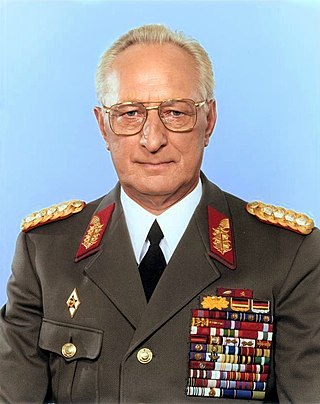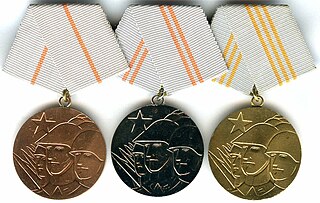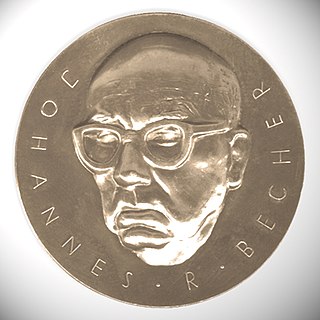
The National People's Army were the armed forces of the German Democratic Republic (GDR) from 1956 to 1990.
Marshal of the German Democratic Republic, was the highest rank in the National People's Army of the former German Democratic Republic (GDR). It was never held and was abolished in 1989.

The Distinguished Service Medal of the National People's Army, or "Medal of Merit of the National People's Army", was a medal issued in the German Democratic Republic (GDR).

The Border Troops of the German Democratic Republic was the border guard of the German Democratic Republic (GDR) from 1946 to 1990.

Heinz Keßler was a German communist politician and military officer in East Germany.

The Sportvereinigung Dynamo was the sport association of the security agencies of former East Germany.

The Medal For Faithful Service in the National People’s Army was a medal issued in the German Democratic Republic (GDR).

Theodor Hoffmann was an East German Admiral who served as the head of the People's Navy (Volksmarine) and as the last Minister of National Defense of the German Democratic Republic and head of the National People's Army.

The Ministry of National Defense was the chief administrative arm of the East German National People's Army. The MND was modeled on the Ministry of Defense of the Soviet Union. The headquarters of the Ministry was in Strausberg near East Berlin. The Guard Regiment Hugo Eberlein provided security and guard services to the Ministry. The Ministry also had its own publishing house, Military publishing house of the German Democratic Republic.

The Medal for Exemplary Border Service was a national award issued in the German Democratic Republic (GDR). It was established on 28 May 1954, by the Council of Ministers of the GDR with Order No. 47/54 from the Ministry of Interior on 16 June 1954. The first presentation ceremony took place on 1 July 1954, to members of the German Border Police.

The Medal for Fighters Against Fascism was an award of the German Democratic Republic given to people who had been active in the German Resistance against Nazism.
Hermann Rentzsch was a Major General of the People's Police and the National People's Army in the German Democratic Republic (GDR). Later he served as Deputy Minister for heavy machinery and equipment of the GDR.

The Medal Brotherhood in Arms of the National People’s Army was a medal issued in the German Democratic Republic (GDR).

Meritorious Military Pilot of the GDR was the highest honorary title awarded to military pilots of the East German National People's Army. It was given in form of a Medal. Established on August 1, 1974 by the Council of Ministers of the GDR, it was awarded until the dissolution of the GDR in 1990.

The East German Republic Day Parade of 1988 was a parade on Karl-Marx-Allee in East Berlin on October 7, 1988, commemorating the 39th anniversary of the establishment of East Germany. Minister of Defense of the GDR Army General Heinz Kessler inspected the parade and Colonel General Horst Stechbarth commanded the parade as the Deputy Minister of Defense. The leader of East Germany Erich Honecker and the Prime Minister of the GDR Willi Stoph attended the parade. The Central Band of the National People's Army performed the military marches.

The East German Republic Day Parade of 1989 was a parade on Karl-Marx-Allee in East Berlin on 7 October 1989 commemorating the 40th anniversary of the establishment of East Germany. This was the last East German Republic Day Parade and the last major East German political event with the regime falling mere weeks later. In Germany, this parade is remembered as the end of "the great period of military parades".

Republic Day was an official holiday in East Germany, celebrated annually on 7 October from 1949 to 1989. Republic Day commemorates the anniversary of the establishment of the German Democratic Republic on 7 October 1949. On Republic Day, the Government of the GDR awarded many people the National Award of the GDR.

Horst Stechbarth was an East German politician and high-ranking military officer in the National People's Army, holding the rank of Generaloberst. He was the Chief of the NVA's Landstreitkräfte and the ex officio Deputy Minister of Defense of the GDR. He was also a member of the Politbüro of the Central Committee of the ruling Socialist Unity Party of Germany (SED).

The Johannes-R.-Becher-Medaille was a civil decoration of East Germany created in homage to the poet and politician Johannes R. Becher. It was awarded by the Cultural Association of the GDR.

Hero of the German Democratic Republic (GDR) was an honorific title awarded by the former East German state, accompanied by a certificate and medal. The title was instituted by the politburo of the Socialist Unity Party on 29 October 1975 as the most prestigious award of the GDR and first awarded on 28 November 1975. In total, it was awarded on 17 occasions to 11 recipients.


















